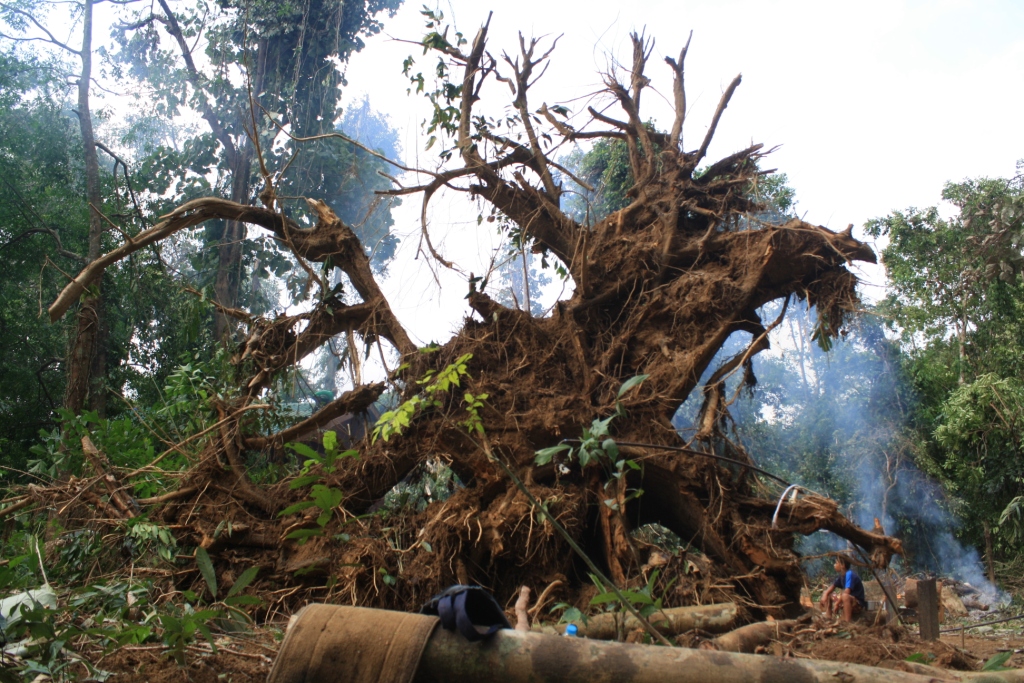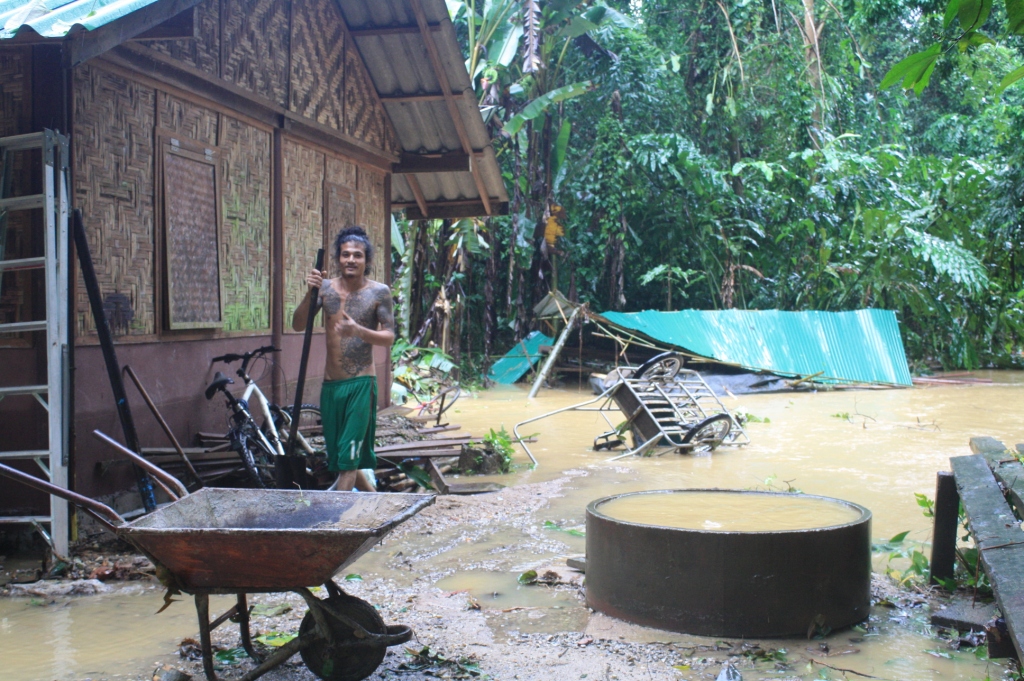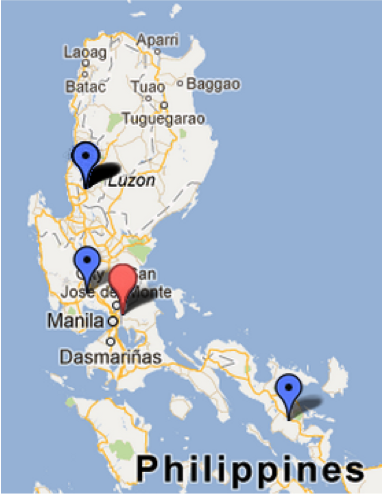Posted - 09/18/2012 The Latest Dirt on C2C by Bodhi Garrett
Earth, wind, and water -
falling sky, rising river, and shaky ground

Over the last few months, I unexpectedly found myself in the midst of a series of natural disasters - a flood, a windstorm, and the aftermath of an earthquake.
Two of these took place in my current hometown - a small village in Southern Thailand where the annual monsoon arrived with unheralded intensity; bringing a windstorm stronger than any local could remember. The fiercest gust of wind lasted only 30 seconds, but was powerful enough to devastate acres of old-growth forest and destroy my next-door neighbor's house. Giant trees came crashing down everywhere, vines and branches propelled outward like shrapnel, leaving giant craters in the ground where the roots had been. Amazingly, no one was hurt, and after a display of such intense power, the skies cleared and the sun came out.

 Nine days later, the monsoon
returned with a vengeance. After 24
hours of torrential downpour, the river overflowed its banks and a meter of
water came pouring through my front door. Luckily, we had time to evacuate, but the
ensuing clean up from both wind and water was a herculean task.
Nine days later, the monsoon
returned with a vengeance. After 24
hours of torrential downpour, the river overflowed its banks and a meter of
water came pouring through my front door. Luckily, we had time to evacuate, but the
ensuing clean up from both wind and water was a herculean task.
The third natural disaster, an earthquake, took place far away in Indonesia, but fear of a subsequent tsunami sent many of my friends and colleagues running for higher ground. After several hours, it became apparent that this horizontally-moving quake had not spawned a killer wave (as a vertical slippage along the fault line might have), but the evacuation process reminded us all of the horrific scenes of December 26, 2004.
The aftermath of these events, as with so many natural disasters, was characterized by a rush to restore short-term normalcy instead of long-term stability, and misunderstanding from outside helpers, but also compassion and mutual aid within the villages. Where some saw the opportunity to regenerate the forest and riverbanks, others rushed to plant commercial palm-oil trees and build riverside hotels.
It has been several years since I was in the midst of a natural disaster, and the experience reaffirmed my conviction that communities can respond gracefully, and that I have the wherewithal to empower this positive response.
We were able to call together the elders of the village, and ask them to take a pause of their own, to consider what they wanted - "recovering" quickly or building back better. The process is underway, I am happy to report that we have managed to delay, if not prevent, the further encroachment of tourist resorts and commercial plantations.
In the middle of all this, I was accepted as an ITP partner, and the timing could not have been better. I am ready to answer ITP's invitation to action. Ready to catalyze insight and clarity in the midst of chaotic situations, and to empower and connect the locals whose vision and determination will create a better future.
Next stop - Manila and Luzon
 With ITP's kind support, I
will be heading to the Philippines in early September to learn from communities
regularly affected by climate disruption, and to see how Filipino civil society
is responding to the front-line effects of changing weather.
With ITP's kind support, I
will be heading to the Philippines in early September to learn from communities
regularly affected by climate disruption, and to see how Filipino civil society
is responding to the front-line effects of changing weather.
My trip will encompass to Dona Pepeng in Manila, a model of urban disaster resilience; the municipality of Guagua in Central Luzon and the province of Albay in Southern Luzon, where the local governments excel in community-based disaster management; and the indigenous community of Ag-agama in the Cordillera regularly, regularly subject to typhoons, drought, pest infestation, and earthquakes.
The Philippines is one of the world's most disaster-prone countries. Roughly 8 disasters a year were recorded between 1900 and 1980, increasing sharply to more than 16 disasters annually in the last three decades. According to local social activist Sonny Melencio, "The large amount of rainfall that the Philippines is experiencing now is indicative of climate change. This has not happened before… What hit the Philippines is not even a typhoon, its monsoon winds and rains, but the amount of rainfall has been reported greater than in the 2009 typhoon.
As I prepare to embark on this exploratory mission, I am preparing my toolkit - an open mind, an optimistic heart, and able hands.
- All
- #ZeroBy2050
- 10Power
- 350 Seattle
- 36.5
- ANHE
- ARC-KE:i
- Al Gore
- Alicia Escott
- American Resilience Project
- Anjali Nayar
- Anthony Myint
- As You Sow
- At the Water's Edge
- Bard Center for Environmental Policy
- Beka Economopoulos
- Biomimicry Collaborative
- Bioneers
- Black Permaculture Network
- Blossoming Possibilities
- Blue Heart Labs
- Bodhi Garrett
- Britta Riley
- Bureau of Linguistical Reality
- C2C(Change 2 Climate)
- CELI
- COP21
- COP22
- California Foodways
- California Institute for Rural Studies
- Carbon Shock
- Casey Beck
- Catalogue of Extinct Experience
- Cathedral of St. John the Divine
- Center for Investigative Reporting
- Change the Bulb
- Chris Desser
- CityLab7
- Clean Energy Leadership Institute
- Climate Change
- Climate Science Alliance
- Climate Solutions Group
- CoClimate
- Convening 2010
- Coronavirus
- Council of Pronghorn
- Daily Acts
- Dancing Earth
- Dancing Without Borders
- Dr. Renee Lertzman
- Dream Rider Productions
- DreamRider Productions
- Duke University
- E2
- Earth Guardians
- Earthseed Consulting
- Eban Goodstein
- Eve Mosher
- Faith Kearns
- GAIA
- Gary Nabhan
- General
- Global Climate Action Summit
- Grant Partner Gathering
- Grant Partner Spotlight
- Grant Partners
- Grant Proposal Application
- Grants
- Happening
- Heidi Quante
- HighWaterLine
- Human Impacts Institute
- Impact Experience
- Impact Hours
- Invoking the Pause
- Joshua Fouts
- KALW
- KQED
- Kelly McVicker
- Kiss The Ground
- Libby Modern
- Lien Tran
- Lindley Mease
- Lisa Micheli
- Lisa Morehouse
- Magalie Bonneau
- Maggie Kaplan
- Mark Hertsgaard
- Mark Schapiro
- McDonalds
- Monica Wilson
- Morgan Curtis
- Natural History Museum
- Newsweek
- Nicole Heller
- Nicole Lederer
- Nina Simons
- Nina Wise
- Optimist Daily
- Pandora Thomas
- Paris COP21
- Pepperwood Preserve
- Peter Cunningham
- Planet Protector Academy
- Planet Protectors
- Post Pause
- Power Shift Network
- Presidio Graduate School
- Psych Alive
- Rainforest Connection
- Rebecca Patton
- Reinhard Hohlwein
- Rulan Tangen
- SPM3
- Sandra Kwak
- Sarah Cameron Sunde
- Science House Foundation
- Seeding Possibilities
- Seeds of Resistance
- Starbucks
- Stephen Antupit
- Sun Valley Forum
- SustainUS
- TIMBY
- Taco Diplomacy
- Tara DePorte
- Tensorflow
- Terry Tempest Williams
- The Arctic Cycle
- The Natural History Museum
- The Optimist Daily
- The Organic Life
- The Perennial
- The Redford Center
- Topher White
- Transition US
- Trathen Heckman
- Tribal Changes App
- University of Miami
- Videos
- Village Green(er)
- Wildlife Conservation Network
- Windowfarms
- Winters Past
- Works on Water
- World Business Academy
- XSproject
- Xi Martinez
- Zero Foodprint
- invoking the Pause

